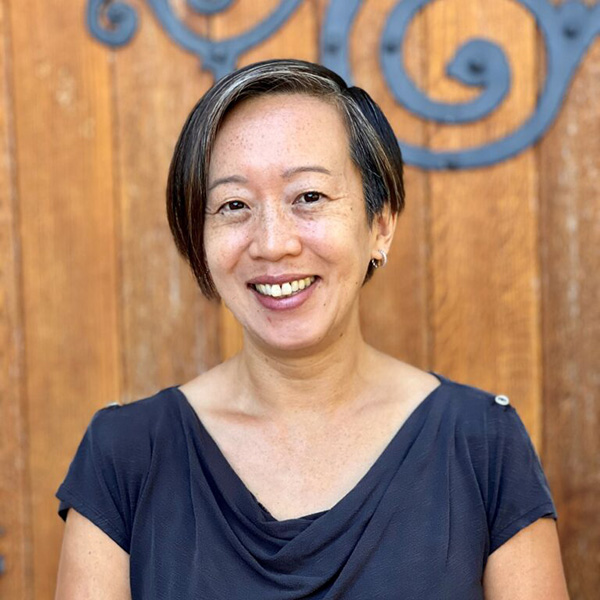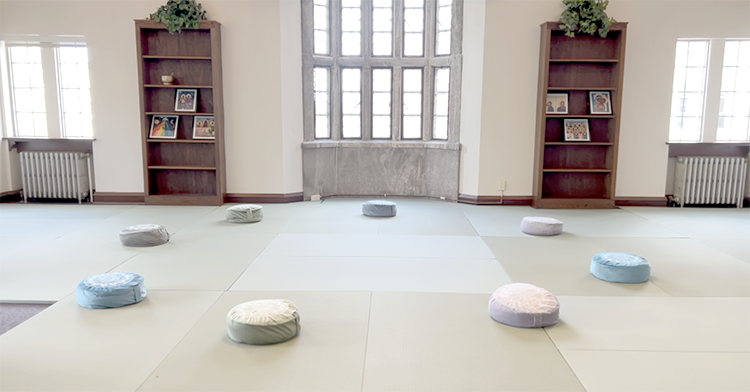Gathering for the Journey
I recently taught a new course for education students at Calvin University called “The Christian Teacher.” I remarked to students early in the semester that teaching it was a vast opportunity for hypocrisy on my part. Teaching about teaching opens one’s own teaching to scrutiny; adding the word “Christian” raises the stakes further.
My first challenge was figuring out how to begin. The beginning should create good initial momentum. It should position us well to start thinking about the core ideas in the course. While few, if any, teaching moves are uniquely Christian, the way we begin should be a plausible extension of Christian convictions. After some reflection, I settled on the following beginning. (It would only work in classes up to a certain size, but as usual my goal is not necessarily for you to copy it, but for you to think about what is happening.)
On the first morning, I moved the tables together so that we could sit in a single large circle. I sat down with the students as they trickled in. After introducing myself, I told them to pair up and ask their partner to share two interesting pieces of personal information that they were willing to have shared with the group. I then asked them to introduce their partner to the rest of us, using that information. As each pair completed their introductions, I quizzed the group cumulatively on what they had heard. I regularly referred us back to earlier introductions (do you remember the name of the person who likes running?) and drew attention to similarities and differences across the group (which three people have a cat?) as an aid to memory. This was easy at the beginning but took more work as more names and details were added.
After about twenty minutes, we all knew everyone’s name and two things about each person. At that point I asked students to think back over what we had done and compare it to other class beginnings they had experienced. What choices had I made that could have been different? Had those choices influenced their perceptions of how this class was going to go? What messages did they take away from how other classes began? Could they already see any beliefs and values leaking through into my teaching, even in these opening minutes of the semester?

I was aiming for some of the same goods involved in another opening activity that I described at length in “On Christian Teaching.” Within the first few minutes, each person got to speak in the relatively safe setting of a conversation with one other person, was heard, actively listened to others, had evidence that someone had listened to them, and was introduced by someone else into the group rather than having to manage that themselves. As usual, my goals were multiple. I wanted to free up cognitive space for learning by quickly addressing the anxieties most experience when beginning a new class with a crowd of strangers. I wanted to sow an expectation that we would focus on speaking our ideas and listening attentively to one another. I wanted to signal the value of each person present and lay some initial groundwork for talking later about Christian understandings of community and how they might relate to classrooms. I wanted to signal that in a class about teaching, my own teaching moves would be as much part of the curriculum and fair game for critique as the ideas in lectures or readings. I wanted to work toward the realization that what at first felt like just a social icebreaker was already a way into the topic and expectations of the class.
That last point is one reason why I do not think there is one ideal way to start class. The opening minutes of class begin to communicate the value system that will shape learning interactions. The opening minutes should also connect coherently with the kind of learning that our course involves. These are not necessarily conflicting goals. With creative planning, our beginning can serve the subject we need to teach as well as the culture we want to create.
Some years ago, after leading professional development at a high school in another city, I found myself back in the area several months later for a conference. A teacher from the school approached me to tell me about how her semester had begun. “When you spoke to us,” she recounted, “it was only a few days until the beginning of the new semester, but I knew I had to change my opening day.” She had decided to rearrange her science course content so that she could open her first class with a visually dramatic experiment. She wanted to give learners a sense on the first day that science learning was going to be engaging and hands-on, and that there could be excitement in studying creation. As she told it, they made things explode on the first day. The effect was lasting. She recounted how her new opening seemed to have improved the way the students viewed her for the rest of the semester, even though the rest of her teaching was mostly unchanged. A perception was established at the beginning that this was an exciting class. Beginnings set baselines and trajectories that can affect the relational fabric and perceptions of the subject matter. They can function as a lens through which students interpret what is to follow.
Student Reflections
Following the first class of my education course, I asked students to journal about their wider experience of class beginnings and how it compared to the beginning we had just practiced. Their responses made fascinating reading as they described their reactions to various instructors’ opening moves.
Some noticed that students were facing one another and that the professor was sitting among them at the start of our course. Both things stood out to them as different. They wrote of their dawning hunch that the instructor might be approachable, that, as they put it, the professor might be a human being. (I am not sure what other kind of being they might expect to lead a class, but the choice of words seems telling.) They contrasted this with classrooms in which, as Jasmine put it, “the placement of the people, desks, actions, and gestures showed that [the teacher] was the one with power and we were not.”
Several students described other classes that had begun with extended passivity on their part. Hannah wrote this: “One of my classes this semester began by going over the syllabus for the first thirty minutes of class with no introduction. I began to stress that this class would be boring for the entire semester. I was planning how I would combat sleepiness and boredom in the class and becoming more anxious as the mundane lecture drew longer and longer. However, the professor switched after 30 minutes of lecture into the last few minutes of class getting to know each other, and immediately my perspective on the class was changed.” Notice how quickly the challenge of paying attention leads to imagining future learning experiences. Hannah wondered aloud how she might have viewed the class differently if the interaction had come sooner. Sage similarly highlighted how the beginning of a class could leave her anticipating future negative experiences: “I have experienced circumstances in high school where the teacher walked in the classroom and told us to immediately grab our textbooks and get to work. The dynamic in the classroom following this bland introduction was lackluster and I would often dread having to spend an hour in the classroom with that teacher.”
Most striking to me were students’ reflections on the consequences of ignoring the relational fabric of the group. Some commented that even when teachers invested time in learning the names of students, it was rare for time to be invested in students knowing anything about one another. That affected future interactions as courses progressed. Claire described being in a class in which she “never really got to know the other students.” She noted: “It made for a tough transition when it came time to do randomly assigned group projects; we had no idea who was who or where to sit.” Maddy made a similar observation following our opening memory game. “We can work together if there are difficult assignments without feeling like strangers,” she wrote. “I also felt like the professor cared about each person, instead of just seeing us as students to teach.” Aaron pointed to the connection between the opening activity and his sense of engagement: “The entire setup of the classroom made me realize … that the whole class is in this ride together, while in a typical classroom everyone sits down and doesn’t talk on the first day. This makes me feel alone and it’s just me in this classroom doing what I have to do to pass.” As we discussed the dynamics of collaborative work later in the semester, students returned to these themes, with many commenting that not knowing the students with whom they were asked to collaborate on group tasks made them more likely to just focus on getting the task completed with minimal interaction, resulting in something more like parallel solo effort than real collaboration. As FengYang expressed it, group work then becomes “more like individual work on a big assignment separately.”
I share these student responses neither because they are systematic data nor because this particular activity is now the correct way to begin class. I am simply seeking to illustrate how our opening moves in class are being read by students. Their first impressions can quickly turn into expectations about how the rest of the course is going to go. Those initial perceptions can change later; what happens next does of course matter a great deal. But they can also continue to influence future engagement.
I noted above that one of my goals was to model a way of teaching that was tethered to Christian concerns. I did not in this instance begin with devotions or prayer. If I had, then we would need to think about how the meaning of that beginning might depend on my posture, my tone, the topics mentioned in prayer, and the differing relationships to faith among my students. But on this occasion, I began without explicit religious behavior.
Even so, my desire to lay the groundwork for building a community of mutual care in the classroom was informed by my faith. I was conscious that a course called “The Christian Teacher” had potential to generate anxiety, an expectation of official right answers backed by the might of Bible verses, or self-righteousness from instructor or students. I wanted to begin to build norms of interaction that could sustain us in humble, reflective, honest inquiry. I wanted to avoid looming over the students at the beginning. I also wanted to sow some seeds in preparation for reading theological accounts of Christian community two weeks later and discussing what they might have to do with teaching. None of this means that Christian doctrine authorizes my opening activity as the best way to proceed. It does mean that my choices were informed by my faith along with whatever wisdom I have gained about how learning works.
There are many valid ways to begin, yet there are also less optimal ways, not just in terms of whether they succeed at getting learning started but also in terms of what story they imply. Our first actions in a course can communicate courage or anxiety, hope or cynicism, isolated productivity or communal inquiry, delight in the world or the need to control, pride in our status or humility, the pursuit of shalom or consumer boredom, vulnerability to students or self-protection. Our first actions give hints to students about who we think they are and what they are likely to experience at our hands. Being intentional about how we start is one way of stating what we value.
Exercises
- Choose a course or sequence that you teach. What is the first thing that students are asked to do? Do they do it alone or together, aloud or in silence, quickly or slowly? What do those first moves imply about what will be important in the course? What do those opening moves suggest regarding your beliefs about teaching and learning?
- What do students learn in the first week of your classes about how they should expect to relate to one another during the semester? Make your own notes on this and then invite some of your students to share their own perceptions.
- Identify one Christian conviction that you hold about your students and their needs. Outline one way in which it could be communicated, explicitly or implicitly, through an opening activity in a course or topic sequence. Then set that activity aside and repeat the exercise, connecting the same conviction to a different opening activity. Enlist a friend or colleague in a conversation about the benefits and drawbacks of each activity.
Excerpted from “Everyday Christian Teaching: A Guide to Practicing Faith in the Classroom” by David I. Smith ©2025. Reprinted by permission from Wm. B. Eerdmans Publishing Co.









